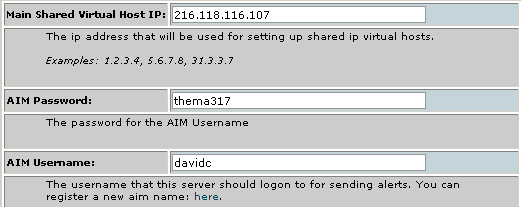Editing your server setup
The Edit Setup area enables you to edit your server configuration settings that you created during the installation and initial logon process (refer to Logging on for the first time if you have not logged on yet). This includes editing your master IP address, BIND version, contact details if problems occur, and related information.
Warning: Do not change your server settings unless you are absolutely sure you know what you are doing. Altering these settings incorrectly can result in CPanel and WebHost Manager functioning incorrectly.
To edit your server setup:
Click on the Edit Setup link in the Server Setup menu.
Enter the hosting IP address, AIM (AOL Instant Messenger) username and password, and BIND version in the Main Shared Virtual Host IP, AIM Password, AIM Username, and BIND Version fields.
Enter your administrator's contact details in the Server Contact AIM and Server Contact ICQ UIN fields.
Enter the name of the default CPanel theme that you want to use in the Default CPanel Theme field. Refer to Themes for more information about themes.
Enter the name of the ethernet device that you are using in the Alternate Main Ethernet Device field, if required. You only need to do this if you are using an ethernet device that is not the first ethernet device on the machine.
Enter the default home directory where new users accounts will be created and the prefix that matches other user partitions in the Default Home Directory and Home Directory Prefix fields.
Enter the current hostname of your server in the Hostname field.
Enter the ICQ password and UIN for whomever deals with system alerts in the ICQ Password and ICQ UIN fields.
Enter the name of the type of Apache logs that you want to receive. Two options are available:
combined - All information is logged, including referrers, user agents, and requested files.
access - Only information about requested files is logged.
Enter the lowest UID number to start from when creating accounts in the Minimum Uid field, if required.
Enter up to three nameserver names in the Primary Nameserver, Secondary Nameserver, and Third Nameserver fields. The Primary Nameserver and Secondary Nameserver fields are mandatory.
Choose whether you want users to have CGI access in the CGI Script Alias field. y = Yes, n = no.
Enter the IP address of the master nameserver in the Master Nameserver field, if required.
Warning: This will turn your server into a slave server if this option is enabled. It is advisable to establish a key rust relationship with the master nameserver after enabling this option - refer to Establishing a trust relationship for more information.
Enter the server administrator's contact details in the Server Contact E-Mail Address and Server Contact Pager Address fields.
Enter the IP address of the master cluster server in the Master Cluster Server field, if required.
Click on the Save button.

